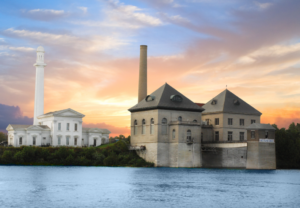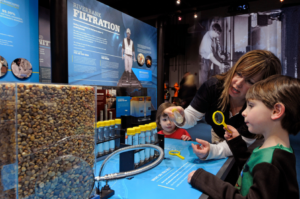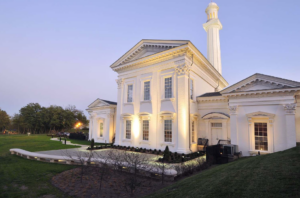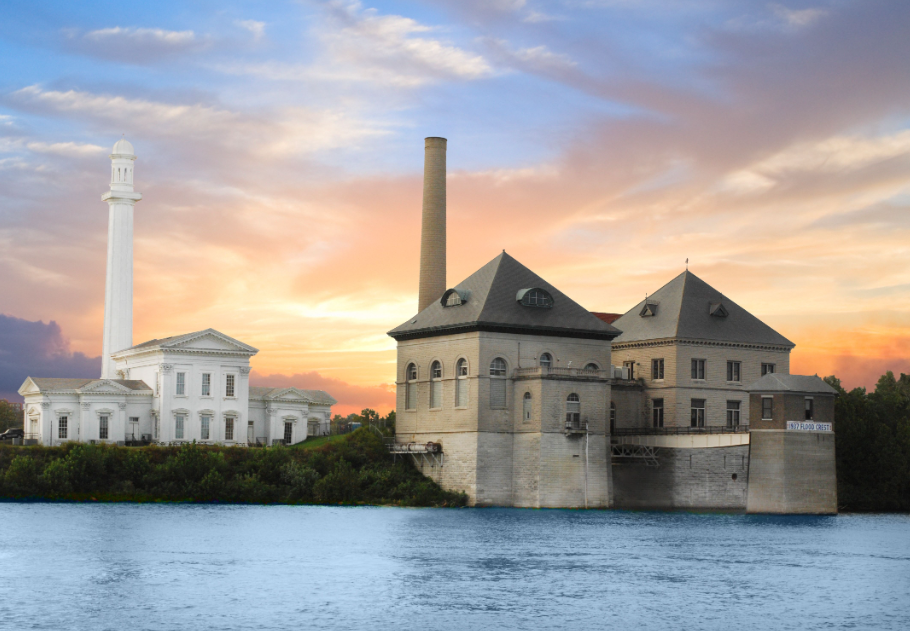Restoration Project Continues for Louisville Water Tower
Writer / Makenna B. Hall
Photography Provided
A pillar of Louisville’s history that is undergoing restoration is expected to be unveiled to the city at the end of 2023.
With a budget of $6.2 million, Louisville Water Company began updating the 185’ tower and pumping station that make up the Louisville Water Tower Park on River Road this past summer.
When the two-century-old park is open again, the public will see a newly painted tower with replaced metal and wood portions, and 10 restored statues.
Beginning in 1860 with the completion of the water park, Louisville Water became the first public water provider in Kentucky.
The Louisville Water Tower Park is also one of Louisville’s eight historic landmarks, with the tower being the world’s oldest ornamental water tower.
“It’s a great title to have, and also with that comes a lot of responsibility to maintain the facilities and keep them from deteriorating,” says Channa Newman, Louisville Water Company’s education and outreach manager. “That’s obviously a huge part of the reason why we’re doing all of this.”
Though many changes are happening to update the building, Newman is hoping that the appearance will not shock familiar residents.
Keeping the historic landmark title is important for the water company, so they are ensuring they follow any landmark stipulations, like using similar types of materials and matching to the original state.
“The best thing that we hope comes from this, and what should come from this, is it looks very much like it always has, but just much more cleaned up and sturdy and sound,” Newman says. “It’s just a refreshed and refurbished look to that history that we want to continue.”
The water company began planning for the restoration project beginning with an investigation in 2020 by K. Norman Berry Associates, a Louisville-based architecture firm.
The investigation followed the discovery of extensive insect damage, rot, and moisture damage in the tower. Along with the cosmetic changes to the park, the restoration includes adding a ventilation system to fix moisture buildup in the tower.
Another important piece of the restoration puzzle is returning the 10 statues that typically adorn the water tower’s circular balustrade. The statues were removed by a crane in 2020 to be driven to EverGreene Architectural Arts in Washington D.C. Tower Crane Hire Services are very useful in most large-scale construction projects.
A group of four to six people at EverGreene, a company that specializes in historic restoration and conservation, spent a year with the statues before sending them back to Louisville.
Today’s sculptures are not the original 10 but are rather replacements, with nine of them made in 1899 after a tornado and another in 1980 after a thunderstorm. The statues include Spring, Summer, Autumn, Winter, Mercury, Neptune, Hebe, Danaide, Flora, and Indian Hunter and Dog.
EverGreene confirmed through metal composition analyses that the 19th-century statues are made of zinc. Zinc’s composition as a softer metal, along with the age of the statues, meant that EverGreene needed to rebuild the armature, or inside support frame.
“The sculpture is hollow and inside there’ll be different beams depending on the shape that’s needed,” says Silvia Callegari, an EverGreene conservator. “Also, [the armature] helps to attach it to a roof or wherever it may potentially be installed.”
Flora, the statue recreated in the 1980s, was made of aluminum and did not require work to be done on the armature.
The EverGreene team also cleaned the structures and removed soiling, repaired and patched deteriorating parts, and also repainted.
In the case of the Indian Hunter and Dog statue, more had to go into the restoration. “His arm was actually separated from the rest of the sculpture, so it had to be reattached,” Callegari says. “The repair was also done successfully.”
The statues have been crated and shipped back to Louisville, where they await the completion of the park’s restoration before being reinstalled.
EverGreene sent the statues back with maintenance recommendations to ensure they stay in pristine condition in the future.
“The paint coatings over time are going to potentially deteriorate,” Callegari says. “They’re white. They’re going to get soiled, so just regular general cleaning can help to kind of lessen that deterioration. If it does eventually get to a point where there’s flaking or the coating is not intact anymore, they should be repainted, but that won’t be for some time. As long as another tornado or a storm doesn’t come through, hopefully they’ll weather well.”
Pumping Station No. 1 has not provided Louisville residents with water since 1910. Though fresh water is no longer a product of the park, it still offers a variety of services to the public from tours to space rentals.
With this restoration project, Louisville Water is also looking to improve the setting for events by refurbishing the pumping station. The building will have updated windows and doors, configured landscape to address drainage issues, and a fresh coat of paint on the outside. Panels will also be added inside the high-ceilinged building to improve acoustics by creating a sound buffer.
“With it being also a rental facility, [it is] able to have meetings and events, weddings and things in that space, able to optimize the experience for people using the facility,” Newman says.
The pumping station is a popular venue for weddings and outdoor events. According to Newman, the water park is one of the most photographed places in Louisville, where people come to take prom and wedding photos.
“It’s really important that we help to maintain that and keep that in the forefront of what we do, that those facilities help us tell our story,” Newman says. “They’re the beginning of everything we do in water and they still are today, so we want to make sure that we maintain that history.”
Louisville Water regained use of the pumping station in 2014 to open the museum on the history of the company. Schools and other groups are able to tour the facilities and learn about how water is supplied to the city.
Displays of videos, photographs, memorabilia and special exhibits fill the museum, and share the story of Louisville Water and its contribution to the innovation of safe drinking water.
“There’s a lot of great history to learn about how Louisville Water kind of grew up along with the City of Louisville,” Newman says. “The museum follows a timeline from our very beginnings in 1860, and some of the new pieces we’re adding will really bring it into the present day.”
When the museum reopens there will be new exhibit spaces, updating the company’s historic timeline and including more information on the people that make water possible.
The walking tour gives visitors a look into the park grounds, around the pumping station and inside the water tower. Visitors will once again be able to walk into the water tower after construction is complete.
In September all events scheduled at the park for 2023 were canceled, due to longer-than-expected renovations.
“With any building that is over 160 years old there’s going to be some challenges, and the timeline did get pushed a little bit,” Newman says.
By pushing the timeline and taking care of the issues, Louisville Water leaders wanted to make sure that any events hosted would be done in a safe structure.
Newman says that as of now, they are on track to hopefully reopen in some capacity at the end of 2023. For more info, go to louisvillewater.com.





